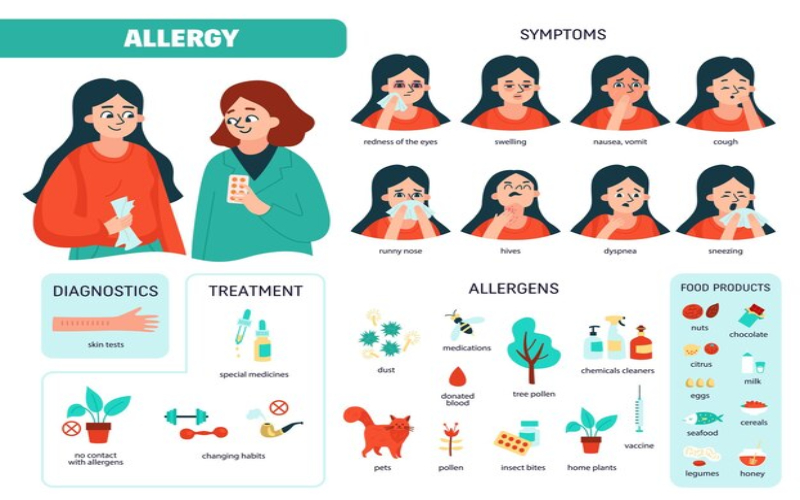
In the United States, allergies are the sixth most common cause of chronic illness. Over 50 million Americans are thought to suffer from some kind of allergy. An allergen, which is a foreign material, triggers an Immunological response or overreaction in people with this illness. Many foreign substances can trigger an allergic reaction, ranging from medications, pets, foods and airborne particles inhaled through the lungs. The symptoms can range from moderate (coughing, itchy eyes, a scratchy throat, sneezing, hives, and a runny nose) to severe and occasionally life-threatening (triggering an asthma attack, difficulty breathing, low blood pressure, and even death) depending on the kind of allergy and the degree of the reaction.
Types of Allergies
The 6 Common Types of Allergies :-
- Food Allergies: Allergens can come from any food. The reaction may be categorized as a food sensitivity or intolerance rather than an allergy depending on the food and how the body reacts. As opposed to allergies, lactose intolerance is the inability to digest the lactose found in milk. Symptoms of a food allergy may include hives, itching, vomiting, nausea, diarrhea and swelling around the mouth. Here are some of the most typical food allergies:
- Milk
- Eggs
- Soy
- Peanuts
- Shellfish
- Wheat
- Tree nuts
- Fish
- Drug Allergy: In a drug allergy, immune compounds called Immunoglobulin E antibodies react to the drug. The medicine might trigger allergic symptoms across the body as it circulates throughout the entire body. Symptoms may include wheezing, hives, throat, shortness of breath and mouth swelling, diarrhea, fainting or vomiting. If it is suspected that you may have a drug allergy, Dr. Sheetu Singh can test for an Immunoglobulin E (IgE) response to certain diseases. The most typical medication allergy, affecting 10% of persons, is Penicillin.
- Latex Allergy: Natural rubber products manufactured from the sap of the Brazilian rubber tree include latex. Inhaling latex fibers or coming into physical contact with a latex product can both cause an allergic reaction. The following are some items that contain Latex: –
- Bandages
- Rubber balls
- Rubber bands
- Balloons
Rubber household gloves
Symptoms of a latex allergy typically include itching, swelling and redness after coming into contact with Latex.
- Insect Allergy: A localized reaction, such as itchiness, swelling, redness or discoloration where the bite or sting occurred is normal; nevertheless, some people experience an excessively severe reaction to bites. Stinging insects like wasps, bees, hornets, fire ants and yellow jackets are most likely to cause an allergic reaction and the reaction can be severe. It’s crucial to get medical assistance right away if you experience an allergic reaction as it may be fatal. These are some possible early signs:
- Dizziness
- Fainting
- Swelling of the tongue, lips or throat
- Itching, skin rashes or hives
- Having the impression that something terrible is about to occur
- Vomiting, stomach pain, diarrhea or bloating
- Trouble breathing, shortness of breath or wheezing
- Airborne Allergens: The most ordinary allergy triggers are small-scale particles found in outdoor and indoor air. These airborne particles have the potential to inflame and swell the sensitive tissue surrounding the eyes as well as the nasal airways. This, in turn causes symptoms commonly associated with allergies such as watery eyes, runny nose, itchy, congestion and sneezing. Common allergens in the air include:
- Dust mites: These are tiny organisms that live in dust in box springs, pillows, mattresses, sofas, carpets and other household objects.
- Mold: Mold releases spores, which are inhaled microscopic particles. Mold is frequently found indoors in moist areas like the kitchen and bathroom, as well as outside in Mulch, leaf piles and tree stumps.
- Pollen: This is a substance that trees and plants release at specific periods of the year. The spring and fall tend to be the worst seasons for it.
- Animal dander: Pets secrete proteins in their saliva and perspiration that might cause an allergic reaction. These proteins are then expelled as dander or dead skin cells.
- Skin Allergens: Skin allergies are more common in people with sensitive skin and skin conditions like Eczema. An allergic reaction may be triggered by chemicals in detergents, skincare products and soaps as well as contact with plants such as poison oak, poison ivy and poison sumac. Symptoms may include inflammation, formation of dry, rash, hives and itchy patches.
Types of Allergic Reactions
The immune system’s response to an allergen causes an allergic reaction. Reactions can be classified as mild, moderate and severe with symptoms as follows:
- Mild: This type includes nasal symptoms including itchy, watery eyes, congestion, and runny nose as well as localized reactions, such as rash or hives when contact with an allergen occurs.
- Moderate: These include signs and symptoms that affect different bodily areas, such as wheezing, breathing issues, hives, and swelling or inflammation.
- Severe: Anaphylaxis shock is a potentially fatal reaction that needs immediate medical attention. After coming into touch with the allergen, people may experience symptoms like swelling, hives, cramping, vomiting, diarrhea and throat swelling within minutes.
